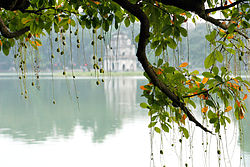Description
This plant is a big tree that grows to about 8–15 meters high. Its leaves are thick, smooth and oval in shape, about 8–12 centimeters long and 4–5 cm wide, with reddish petioles about 0.5–1.0 cm long. The plant has drooping raceme of up to 50 cm long, with numerous large, white flowers. Its fruit is oval-shaped and about 3 cm long, with one seed inside. [4]
Uses
Food
The young leaves of this plant are consumed as food, such as in Vietnam where they are eaten fresh with other vegetables, meat and shrimp. [4]
Medicinal
Research on this plant has reported a number of medicinal uses, including antitumor (seed extract), [5] antibiotic, [6] inhibition of growth of Helicobacter pylori , [7] antinociceptive activity [8] and antifungal activity. [9] [10]
The 1889 book 'The Useful Native Plants of Australia’ records that "In India an extract or juice is obtained from the leaves of this tree which, when mixed with oil, is used in native [sic.] practice for eruptions of the skin. The kernels powdered and prepared with sago and butter, are used in diarrhoea; mixed with milk they produce vomiting (Treasury of Botany). The root is bitter, and is said to be similar to Cinchona, but also cooling and aperient. (Drury)." [11]
Chemistry
Its bark contains potent painkillers, structurally unrelated to known opioid painkillers
Also 3,3'-dimethoxy ellagic acid, dihydromyricetin, gallic acid, bartogenic acid and stigmasterol, [12] triterpenoids, olean-18-en-3beta-O-E-coumaroyl ester and olean-18-en-3beta-O-Z-coumaroyl ester [13] 12, 20(29)-lupadien-3-o [14]
Oleanane-type isomeric triterpenoids:- racemosol A (1) [22alpha-acetoxy-3beta,15alpha,16alpha,21beta-tetrahydroxy-28-(2-methylbutyryl)olean-12-ene] and isoracemosol A (2) [21beta-acetoxy-3beta,15alpha,16alpha,28-tetrahydroxy-22alpha-(2-methylbutyryl)olean-12-ene]. [15]
Saponins,: [16] [17] barringtoside A, 3-O-beta-D-xylopyranosyl(1-->3)-[beta-D-galactopyranosyl(1-->2)]-beta-D- glucuronopyranosyl barringtogenol C; barringtoside B, 3-O-beta-D-xylopyranosyl(1-->3)-]beta-D-galactopyranosyl(1-->2)]-beta-D- glucuronopyranosyl-21-O-tigloyl-28-O-isobutyryl barringtogenol C; barringtoside C, 3-O-alpha-L-arabinopyranosyl(1-->3)-[beta-D-galactopyranosyl(1-->2 )]-beta-D - glucuronopyranosyl barringtogenol C.
This page is based on this
Wikipedia article Text is available under the
CC BY-SA 4.0 license; additional terms may apply.
Images, videos and audio are available under their respective licenses.











